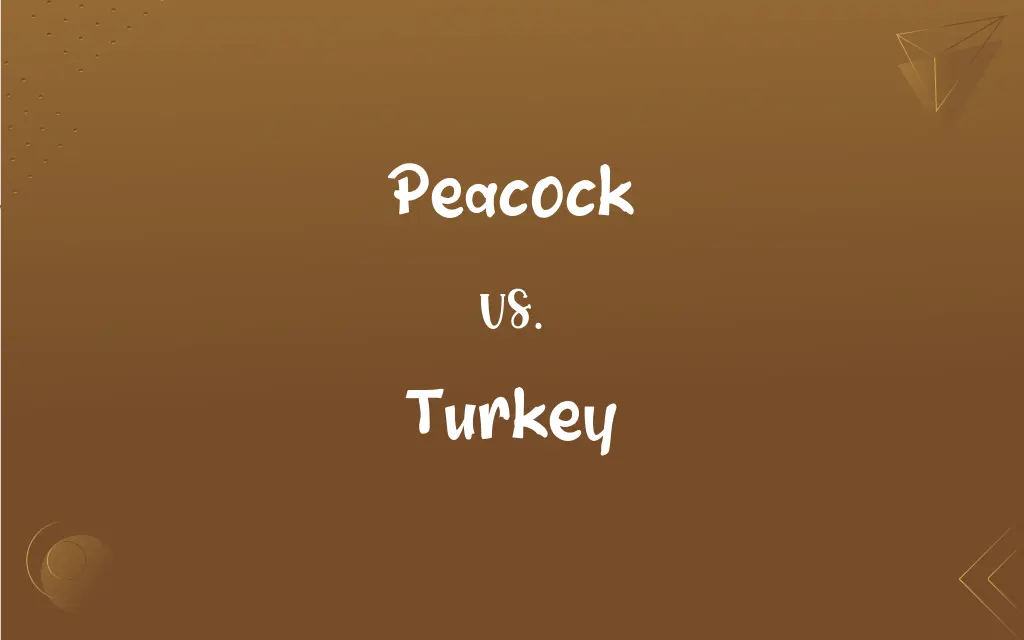Peacock vs. Turkey: What's the Difference?
Edited by Aimie Carlson || By Janet White || Updated on September 25, 2023
A peacock is a colorful, ornate bird known for its iridescent tail feathers, whereas a turkey is a large bird known for its fan-shaped tail and wattle. Both are distinct species with different habitats and behaviors.

Key Differences
A peacock is a symbol of beauty and elegance in the avian world, predominantly due to its vibrant, multicolored plumage and ornate tail feathers. These exquisite features are characteristic of the male species, utilized primarily for courtship displays. A peacock’s vibrant colors and intricate patterns are distinctive, allowing it to stand out amongst other avian species. Its flamboyant appearance is associated with various cultural and spiritual symbolisms, representing beauty, immortality, and refinement across different civilizations.
In contrast, a turkey is recognized by its substantial size, fan-shaped tail, and the distinctive wattle hanging from its beak. Unlike the peacock, both male and female turkeys have less vibrant feathers, primarily in brown tones, serving as camouflage. Turkeys are renowned for their social and foraging behaviors, usually moving in groups while searching for food. These birds are native to North America and are integral to the region's ecology and have significance in American culture, notably as a traditional dish during Thanksgiving.
Diving deeper into their habitats, peacocks predominantly inhabit the Indian subcontinent and Sri Lanka, thriving in forested areas and near water sources. Their adaptability allows them to coexist with humans, often frequenting areas near villages. The peacock’s natural environment is integral to its survival, offering the necessary resources and conditions to sustain its life and propagate its species.
Turkeys, alternatively, are indigenous to the forests of North America, adapting to various environments, from forests to grasslands. They are ground-feeding birds, consuming a varied diet including seeds, berries, and insects. The adaptability of turkeys to diverse ecosystems denotes their ecological versatility, contributing to the ecological balance and biodiversity of their habitats.
Summarizing, the primary differences between peacocks and turkeys arise from their physical characteristics, habitats, behaviors, and cultural significances. While peacocks are revered for their dazzling plumage and symbolic value, turkeys are valued for their ecological role and cultural importance, especially in American traditions.
ADVERTISEMENT
Comparison Chart
Appearance
Vibrant and multicolored plumage
Large, with primarily brown feathers
Habitat
Indian subcontinent and Sri Lanka
North America
Behavior
Known for courtship displays
Move in groups and are known for foraging behavior
Significance
Cultural and spiritual symbolisms
Significant in American culture, especially during Thanksgiving
Adaptation
Coexists with humans and adaptable to various habitats
Adaptable to diverse ecosystems
ADVERTISEMENT
Peacock and Turkey Definitions
Peacock
Inhabits areas in the Indian subcontinent and Sri Lanka.
We observed a peacock gracefully walking in the forests of India.
Turkey
Known for its distinctive wattle and less vibrant brown feathers.
The turkey’s wattle is a distinctive feature of its appearance.
Peacock
A male peafowl with iridescent blue or green plumage.
The peacock spread its vibrant tail feathers to attract a mate.
Turkey
A large bird native to North America with a fan-shaped tail.
The turkey wandered through the woods, foraging for food.
Peacock
Can refer to an ostentatious or self-centered individual.
He strutted around like a peacock, flaunting his achievements.
Turkey
Served as a traditional dish during Thanksgiving in the United States.
Every Thanksgiving, we roast a turkey for dinner.
Peacock
Known for elaborate courtship displays involving plumage.
The peacock performed an elaborate dance to woo the peahen.
Turkey
Represents failure or a flop, especially in show business.
The movie was a turkey and received poor reviews.
Peacock
A male peafowl, distinguished by its crested head, brilliant blue or green plumage, and long modified back feathers that are marked with iridescent eyelike spots and that can be spread in a fanlike form.
Turkey
Exhibits social behavior, often moving in groups called rafter.
A rafter of turkeys moved through the field together.
Peacock
A peafowl, either male or female.
Turkey
A large North American bird (Meleagris gallopavo) that has brownish plumage and a bare wattled head and neck and is widely domesticated for food.
Peacock
A vain or ostentatious person.
Turkey
The flesh of this bird, used as food.
Peacock
To strut about like a peacock; exhibit oneself vainly.
Turkey
A related bird (Meleagris ocellata syn. Agriocharis ocellata) of Mexico and Central America, brilliantly colored and having eyelike spots on its tail.
Peacock
A male peafowl, especially Pavo cristatus, notable for its brilliant iridescently ocellated tail.
Turkey
A person considered inept or undesirable.
Peacock
A peafowl (of the genus Pavo or Afropavo), either male or female.
Turkey
A failure, especially a failed theatrical production or movie.
Peacock
A vainglorious person from the 14th c..
Turkey
(Sports) Three consecutive strikes in bowling.
Peacock
(entomology) Any of various Asian species of papilionid butterflies of the genus Papilio.
Turkey
The guinea fowl (family Numididae).
Peacock
(intransitive) To strut about proudly or haughtily.
Turkey
(countable) A bird in the genus Meleagris with a fan-shaped tail and wattled neck, especially the wild turkey (Meleagris gallopavo, now domesticated).
Peacock
(intransitive) To engage in peacocking, ostentatious dress or behaviour to impress women.
Turkey
(uncountable) The flesh or meat of this bird eaten as food.
All week after Thanksgiving, I had turkey sandwiches for lunch.
Peacock
The male of any pheasant of the genus Pavo, of which at least two species are known, native of Southern Asia and the East Indies.
Turkey
(countable) With a distinguishing word: a bird resembling the Meleagris gallopavo (for example, the brush turkey or bush turkey (Alectura lathami), and the water turkey (Anhinga anhinga)).
Peacock
In common usage, the species in general or collectively; a peafowl.
Turkey
An act of throwing three strikes in a row.
Peacock
European butterfly having reddish-brown wings each marked with a purple eyespot
Turkey
A patient feigning symptoms; a person faking illness or injury; a malingerer.
Peacock
Male peafowl; having a crested head and very large fanlike tail marked with iridescent eyes or spots
Turkey
A pack carried by a lumberman; a bindle; also, a large travel bag, a suitcase.
Peacock
Symbolizes beauty, immortality, and refinement in various cultures.
In mythology, the peacock is often associated with divine beings.
Turkey
A failure.
That film was a turkey.
Turkey
A foolish or inept person.
The turkey cut in front of me and then berated me for running into him.
Turkey
A country in the southeast of Europe and southwest of Asia.
Turkey
Any large American gallinaceous bird belonging to the genus Meleagris, especially the North American wild turkey (Meleagris gallopavo), and the domestic turkey, which was probably derived from the Mexican wild turkey, but had been domesticated by the Indians long before the discovery of America.
Turkey
Large gallinaceous bird with fan-shaped tail; widely domesticated for food
Turkey
A Eurasian republic in Asia Minor and the Balkans; achieved independence from the Ottoman Empire in 1923
Turkey
A person who does something thoughtless or annoying;
Some joker is blocking the driveway
Turkey
Flesh of large domesticated fowl usually roasted
Turkey
An event that fails badly or is totally ineffectual;
The first experiment was a real turkey
The meeting was a dud as far as new business was concerned
Turkey
Wild turkey of Central America and northern South America
FAQs
Do peacocks have symbolic meaning in cultures?
Yes, peacocks symbolize beauty, immortality, and refinement in various cultures.
Do only male peacocks have colorful plumage?
Yes, male peacocks have vibrant and colorful plumage used for courtship displays.
Are peacocks found in the Indian subcontinent?
Yes, peacocks predominantly inhabit regions in the Indian subcontinent and Sri Lanka.
Is peacock only used to refer to male peafowls?
Yes, “peacock” specifically refers to males, while females are “peahens” and the generic term is “peafowl.”
Is the turkey's wattle a unique feature of its appearance?
Yes, the wattle is a distinctive, fleshy lobe hanging from the beak of a turkey.
Is turkey a traditional Thanksgiving dish?
Yes, turkey is a central part of Thanksgiving meals in the United States.
Are turkeys native to North America?
Yes, wild turkeys are indigenous to North America.
Can the term turkey refer to a failure?
Yes, in slang, “turkey” can mean a failure or flop, especially in show business.
Do turkeys exhibit social behavior?
Yes, turkeys are social birds, often moving in groups known as rafters.
Can peacock also mean a vain or self-absorbed person?
Yes, colloquially, a “peacock” can refer to someone who is ostentatious or self-centered.
Can both peacocks and turkeys be seen in zoos?
Yes, both peacocks and turkeys are commonly housed in zoos for public viewing.
Is the peacock's colorful plumage used for attracting mates?
Yes, male peacocks use their colorful plumage in elaborate courtship displays to attract females.
Can turkey refer to a large domesticated bird used for food?
Yes, turkey typically refers to a large domesticated bird consumed as food, especially during Thanksgiving.
Are peahens less colorful than peacocks?
Yes, peahens typically have more subdued and less colorful plumage compared to peacocks.
Are turkeys adaptable to different ecosystems?
Yes, turkeys are versatile and can adapt to a variety of ecosystems from forests to grasslands.
About Author
Written by
Janet WhiteJanet White has been an esteemed writer and blogger for Difference Wiki. Holding a Master's degree in Science and Medical Journalism from the prestigious Boston University, she has consistently demonstrated her expertise and passion for her field. When she's not immersed in her work, Janet relishes her time exercising, delving into a good book, and cherishing moments with friends and family.
Edited by
Aimie CarlsonAimie Carlson, holding a master's degree in English literature, is a fervent English language enthusiast. She lends her writing talents to Difference Wiki, a prominent website that specializes in comparisons, offering readers insightful analyses that both captivate and inform.































































